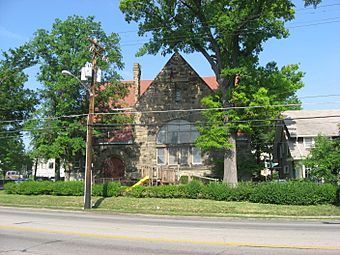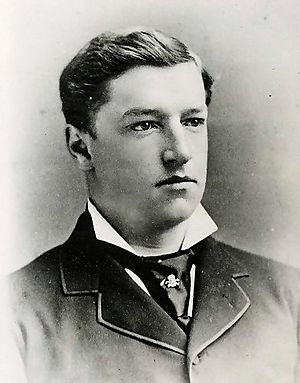First Unitarian Church (Cincinnati, Ohio) facts for kids
Quick facts for kids |
|
|
First Congregational-Unitarian Church
|
|

Front of the church
|
|
| Location | 2901 Reading Rd., Cincinnati, Ohio |
|---|---|
| Area | Less than 1 acre (0.40 ha) |
| Built | 1889 |
| Architect | James W. McLaughlin |
| Architectural style | Richardsonian Romanesque |
| NRHP reference No. | 76001434 |
| Added to NRHP | May 28, 1976 |
The First Unitarian Church is a historic church in Cincinnati, Ohio, United States. It is part of the Unitarian Universalist Association. This church was started in the early 1800s. It went through some splits and then reunited during the 19th century. Many important people have worshipped in its building. This includes members of the Taft family, like William Howard Taft, who became a President of the United States.
Contents
History of the Church
In 1828, a Unitarian minister from Boston visited Cincinnati. His name was John Pierpont. He stayed for about five weeks. When he went back to New England, he told everyone how great Cincinnati was. Because of his visit, a Unitarian church was started in the city within two years.
Their first church building was in downtown Cincinnati at Fourth and Race Streets. It opened on May 23, 1830. Later, they built a new church nearby at Eighth and Plum Streets. In its first year, the church had many young ministers. These early leaders were very well-known. However, many of them left their jobs early because they became sick. This meant the church often needed to find new ministers from New England.
One of these ministers was William Henry Channing. He led the church from 1839 to 1844. After him came James H. Perkins, who was a lawyer before becoming a minister. He served for five years and worked on many social justice issues. He helped with prison reforms and cared for the poor. Sadly, he drowned in 1849.
In the 1850s, the church faced some problems. There were strong disagreements about ending slavery. Cincinnati was very close to Kentucky, which was a slave state. Also, people disagreed about whether miracles were real. These disagreements caused the church to split into two groups.
These problems were solved in the 1870s. Both groups decided that miracles were not real. Also, the Thirteenth Amendment had ended slavery in the United States. So, the two parts of the church came back together.
In 1882, George Thayer became the minister. Many church members were moving from downtown to the northern parts of the city. Because of this, the church decided to build a new building. The current church building was built on Reading Road. This was about two miles northeast of their old location.
Church Building Design
In the late 1880s, the church planned to build a new home on Reading Road. This new building was finished in 1889. It was built using rough blocks of stone called ashlar for the outside.
The architect, James C. McLaughlin, designed the church in the Richardsonian Romanesque style. This style uses rounded arch windows. It also has parts that make the building look like it's divided into two sections. The walls are made of random ashlar stone.
One special part of the building is the large rose window on its north side. It was designed by Frederick Wilson, a craftsman from Tiffany. The window shows a big picture of a person representing Truth. McLaughlin used mostly stone to build the church. The foundation is made of sandstone. Other parts of the walls are made from different kinds of stone.
Before this new building, the church had fewer members. This was because many people moved away from its old downtown spot. By moving to a growing neighborhood, the church leaders hoped more people could easily get there. McLaughlin's design included a tile roof and large, golden stained glass windows. There were also two fireplaces in the main worship area, called the sanctuary.
The sanctuary itself is a square room. It measures 56 feet on each side. When it was built, it could hold about 300 people. Under the rose window, there was a large platform. This is where the organ and the hand-carved oak pulpit were located.
The Taft Family Connection
The Taft family was very important to the First Unitarian Church. This included Alphonso Taft and Louise Taft, along with their children. For many years, Alphonso was one of the church's trustees. He even led the board of trustees for a while. Later in his life, he was often away from the church. This was because he had many important jobs, like United States Attorney General and Secretary of War.
Their son, William Howard Taft, was an active member from a young age. He took part in many youth activities at the church. Years later, when he was running for president, the church's minister remembered him. The minister recalled William Howard playing a fairy in a play put on by the church's Unity Club.
As William Howard Taft's government jobs grew, he also attended church less often. But his influence in the church remained strong. For example, the church's minister, who believed in peace, was removed. This happened because Taft publicly supported the United States joining World War I.
Recent Church History
In 1976, the First Unitarian Church building was added to the National Register of Historic Places. It was listed as the "First Unitarian-Congregational Church." It earned this honor because of its important historical architecture.
Two years later, in 1978, many church members worked with musician Richard Waller. They helped create the Linton Chamber Music Series. This was a partnership with the Cincinnati Symphony Orchestra.
Today, the church is still a very active part of the Unitarian Universalist Association. Rev. Constance Simon became the minister in 2018.
See also
 In Spanish: Primera Iglesia Unitaria (Cincinnati) para niños
In Spanish: Primera Iglesia Unitaria (Cincinnati) para niños




